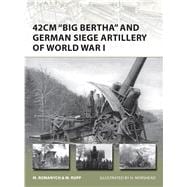Big Bertha, Germany's World War I top secret mobile artillery piece, easily destroyed French and Belgian forts, helping set the stage for trench warfare.
In the first days of World War I, Germany unveiled a new weapon - the mobile 42cm (16.5 inch) M-Gerät howitzer. At the time, it was the largest artillery piece of its kind in the world and a closely guarded secret. When war broke out, two of the howitzers were rushed directly from the factory to Liege where they quickly destroyed two forts and compelled the fortress to surrender. After repeat performances at Namur, Maubeuge and Antwerp, German soldiers christened the howitzers 'Grosse' or 'Dicke Berta' (Fat or Big Bertha) after Bertha von Krupp, owner of the Krupp armament works that built the howitzers. The nickname was soon picked up by German press which triumphed the 42cm howitzers as Wunderwaffe (wonder weapons), and the legend of Big Bertha was born. To the Allies, the existence of the howitzers came as a complete surprise and the sudden fall of the Belgian fortresses spawned rumors and misinformation, adding to the 42cm howitzer's mythology.
In reality, 'Big Bertha" was but the last in a series of large-caliber siege guns designed by the German Army for the purpose of destroying concrete fortifications. It was also only one of two types of 42cm calibre howitzers built for the army by Krupp and only a small part of the siege artillery available to the German Army at the outset of the war. Such were the successes of the German siege guns that both the French and British Armies decided to field their own heavy siege guns and, after the German guns handily destroyed Russian forts during the German offensives in the east in 1915, the French Army abandoned their forts. However, by 1916, as the war settled into a stalemate, the effectiveness of the siege guns diminished until, by war's end, 'Big Bertha' and the other siege guns were themselves outmoded.
This book details the design and development of German siege guns before and during World War I, to include four models of 30.5cm mortars, two versions of 28cm howitzers, and two types of 42cm howitzers (including 'Big Bertha'); in total, eight different types of siege guns. Accompanying the text are many rare, never before published, photographs of 'Big Bertha' and the other German siege guns. Colour illustrations depict the most important aspects of the German siege artillery.








